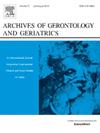随着时间的推移,多病轨迹和模式对中老年人功能限制的影响
IF 3.8
3区 医学
Q2 GERIATRICS & GERONTOLOGY
引用次数: 0
摘要
虽然多病是功能限制的一个危险因素,但很少有研究同时检查多病的轨迹和模式对长期功能限制变化的影响。我们的目的是确定多病的轨迹和模式,并探讨其与中老年人功能限制的关系。方法本研究纳入2008-2021年英国老龄化纵向研究调查中年龄≥50岁的6302名参与者。采用基于群体的轨迹模型来确定22种慢性病(2008-2014)的多发病轨迹。利用2014年收集的数据,采用探索性因素分析评估多病模式。通过广义估计方程模型,研究了在随后的7年(2014-2021年)中,多病轨迹和模式对功能限制变化的影响。结果本研究确定了四种多发病模式:低维持、新增加、中等增加和高维持;四种多发病模式:多系统、心血管、视力损害和代谢-骨骼模式。在所有多病轨迹和模式中,功能限制随着时间的推移持续增加,其水平始终高于参照组(所有P <;0.001)。多病轨迹和模式与时间有显著的相互作用,特别是高维持轨迹(T6:β = -0.218, P = 0.007;T7:β = -0.271, P = 0.004),多系统模式(T6:β = -0.323, P = 0.001;T7:β = -0.593, P <;0.001),代谢-骨骼模式(T6:β = -0.313, P <;0.001;T7:β = -0.481, P <;0.001),表明高维持性多病轨迹、多系统和代谢骨骼模式加速了功能限制的进展。结论对多病高危患者实施针对性的预防干预和个性化的健康管理策略,可延缓残疾的发生。本文章由计算机程序翻译,如有差异,请以英文原文为准。
The impacts of multimorbidity trajectories and patterns on functional limitations over time in middle-aged and older adults
Background
Although multimorbidity is a risk factor for functional limitations, few studies have simultaneously examined the impacts of multimorbidity trajectories and patterns on long-term functional limitations change. We aim to identify multimorbidity trajectories and patterns and explore their relationships with functional limitations in middle-aged and older adults.
Methods
This study included 6302 participants aged ≥50 from the English Longitudinal Study of Ageing survey 2008–2021. Group-based trajectory model was conducted to identify multimorbidity trajectories from 22 chronic conditions (2008–2014). Exploratory factor analysis was employed to assess multimorbidity pattern using data collected in 2014. The impacts of multimorbidity trajectories and patterns on the change in functional limitations across the subsequent 7 years (2014–2021) were examined through generalized estimating equation models.
Results
This study identified four multimorbidity trajectories: low-maintaining, new-increasing, moderate-increasing, and high-maintaining trajectory and four multimorbidity patterns: multi-system, cardiovascular, vision impairment, and metabolic-skeletal patterns. Across all multimorbidity trajectories and patterns, functional limitations showed sustained increases over time, with levels consistently higher than reference groups (all P < 0.001). There were significant interactions of multimorbidity trajectories and patterns with time, particularly for high-maintaining trajectory (T6:β = -0.218, P = 0.007; T7:β = -0.271, P = 0.004), multi-system pattern (T6:β = -0.323, P = 0.001; T7:β = -0.593, P < 0.001), and metabolic-skeletal pattern (T6:β = -0.313, P < 0.001; T7:β = -0.481, P < 0.001), indicating the high-maintaining multimorbidity trajectory, multi-system and metabolic skeletal patterns accelerated the progression of functional limitations.
Conclusions
Implement targeted preventive interventions and personalized health management strategies for high-risk multimorbidity patients to delay disability onset.
求助全文
通过发布文献求助,成功后即可免费获取论文全文。
去求助
来源期刊
CiteScore
7.30
自引率
5.00%
发文量
198
审稿时长
16 days
期刊介绍:
Archives of Gerontology and Geriatrics provides a medium for the publication of papers from the fields of experimental gerontology and clinical and social geriatrics. The principal aim of the journal is to facilitate the exchange of information between specialists in these three fields of gerontological research. Experimental papers dealing with the basic mechanisms of aging at molecular, cellular, tissue or organ levels will be published.
Clinical papers will be accepted if they provide sufficiently new information or are of fundamental importance for the knowledge of human aging. Purely descriptive clinical papers will be accepted only if the results permit further interpretation. Papers dealing with anti-aging pharmacological preparations in humans are welcome. Papers on the social aspects of geriatrics will be accepted if they are of general interest regarding the epidemiology of aging and the efficiency and working methods of the social organizations for the health care of the elderly.

 求助内容:
求助内容: 应助结果提醒方式:
应助结果提醒方式:


